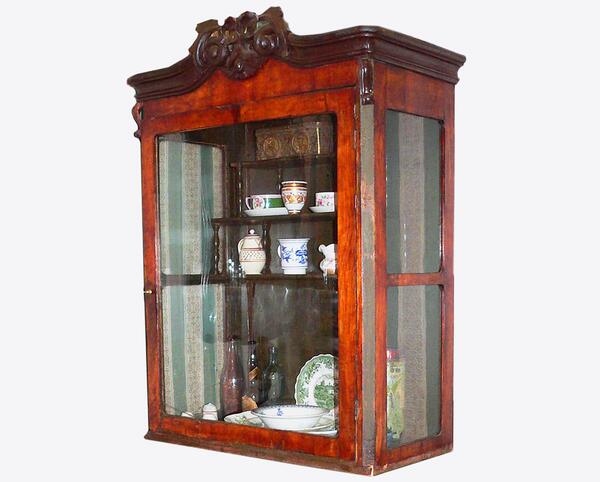A gorka is a display cabinet for porcelain dishes. This one was part of a set of antique furniture that Nikolai Dedushénko donated to the fund of the Kótlas Museum of Local Lore. The gorka is a small wooden cabinet with glazed side walls and a door, and cut front corners. The plywood back wall of the cabinet was constructed by craftsmen. One large wooden shelf is placed inside the cabinet, on which two wooden shelves were placed on legs, step-by-step, one on top of the other. This design resembles a bookcase. The shelf legs are chiseled.
The craftsmen’s design for the gorka is eclectic; it is a mixture, a combination of different styles. They used baroque elements to decorate the gorka - an elaborate rim at the top of the cabinet, and curls above the door and at the front corners. The casing and its carved decorations are covered with dark brown lacquer. The corners of the gorka and the wood carvings on its top are covered with brown paint. The door rests on four hinges, of which two remain original, the other two having to be replaced. In the gorka there is a metal handle, also replaced during use, and a keyhole. These cabinets typically housed fragile and valuable dishes as well as sweets which were locked from children.
The gorka, like other elements of this collection, was made in the city of Kádnikov, presumably by the cabinetmakers Sokrovín and Orlóv, as well as sourced by the foresters Pópov-Vvedénsky, Stratilátov and Súmkin.
Initially, the owners of this set were the Kádnikov merchants of the first Chetverúkhin guild. Evgény Chetverúkhin’s daughter Alexandra married the Kadnikóvsky mayor and merchant Grigory Flyágin, later having a son, Ivan. Growing up, Ivan married schoolteacher Nadézhda Póstnikova, and after the wedding they lived in the Chetverúkhins’ large two-story house, which they inherited. After the death of Ivan Flyágin, Nadézhda, together with her sister Eléna Póstnikova, also a school teacher, moved to the house of the Odintsóv merchants, the upper floor of which was previously bought by Ivan Flyágin. The house of the Chetverúkhins was sold to the Flyágins, and all the furniture remained with the Póstnikov sisters.
The sisters bequeathed their property to Nikolai Dedushénko, a music teacher, watchmaker and tuner of musical instruments, who worked with them at school. He intended to open a historical memorial apartment for repressed teachers. Nikolay brought some of the antique furniture to Kótlas.
The craftsmen’s design for the gorka is eclectic; it is a mixture, a combination of different styles. They used baroque elements to decorate the gorka - an elaborate rim at the top of the cabinet, and curls above the door and at the front corners. The casing and its carved decorations are covered with dark brown lacquer. The corners of the gorka and the wood carvings on its top are covered with brown paint. The door rests on four hinges, of which two remain original, the other two having to be replaced. In the gorka there is a metal handle, also replaced during use, and a keyhole. These cabinets typically housed fragile and valuable dishes as well as sweets which were locked from children.
The gorka, like other elements of this collection, was made in the city of Kádnikov, presumably by the cabinetmakers Sokrovín and Orlóv, as well as sourced by the foresters Pópov-Vvedénsky, Stratilátov and Súmkin.
Initially, the owners of this set were the Kádnikov merchants of the first Chetverúkhin guild. Evgény Chetverúkhin’s daughter Alexandra married the Kadnikóvsky mayor and merchant Grigory Flyágin, later having a son, Ivan. Growing up, Ivan married schoolteacher Nadézhda Póstnikova, and after the wedding they lived in the Chetverúkhins’ large two-story house, which they inherited. After the death of Ivan Flyágin, Nadézhda, together with her sister Eléna Póstnikova, also a school teacher, moved to the house of the Odintsóv merchants, the upper floor of which was previously bought by Ivan Flyágin. The house of the Chetverúkhins was sold to the Flyágins, and all the furniture remained with the Póstnikov sisters.
The sisters bequeathed their property to Nikolai Dedushénko, a music teacher, watchmaker and tuner of musical instruments, who worked with them at school. He intended to open a historical memorial apartment for repressed teachers. Nikolay brought some of the antique furniture to Kótlas.



